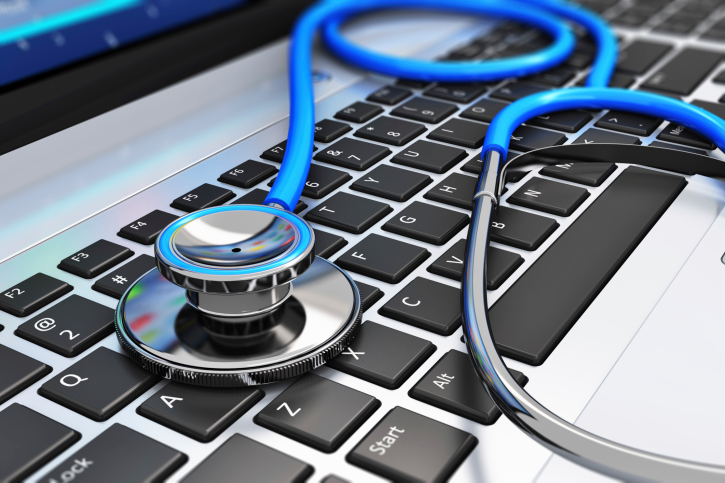You may use Skype for catching up with friends or family. Perhaps you use it to communicate and collaborate with business partners. But have you had a Skype doctor’s appointment? You will—and probably sooner than you imagine.
The healthcare industry is evolving rapidly, and telemedicine (such as our hypothetical Skype doctor’s “visit”) is just one of many emerging game-changers for the field. Here are five technologies transforming healthcare as we know it.
Cloud-Based Medical Records
A majority of providers long ago made the switch from paper medical records to electronic ones (EMR). But moving those records into the cloud will allow for increased access by patients and providers alike. Primary care providers and specialists can form a team around a patient for collaborative, unified care. And, with increased access to their team of providers as well as their medical records, patients will be able to take a more active, informed role in their own care.
Even Smarter Wearables
54% of patients surveyed for Accenture Consulting’s 2015 “Top 5 eHealth Trends” report consider health monitoring their #1 use for smartphone apps. Currently, wearable health and fitness trackers tend to be used for wearers’ own information, increasing awareness of their sleep and exercise habits. Health journaling apps help patients to track changes in long-term conditions such as chronic pain or IBS. Those journals may then be shared with specialists to help inform treatment.
But increasingly sophisticated wearables and their associated platforms will essentially combine the functions of fitness trackers and health journals, with little effort on the part of the patient. Doctors will gain instant remote access to patients’ vital signs, daily habits, flare-up triggers, and more. Wearables will even be able to notify patients if their blood pressure goes too high or allow them to test blood sugar levels with a finger-prick test. This type of monitoring will not only help keep doctors informed on a patient’s condition between visits, it may help to identify health emergencies in the earliest stages—or prevent them altogether.
And it won’t stop at patients’ wearables, or even strictly wearable trackers. Accenture reports that surgeons may use Google Glass and similar devices to monitor patients’ vital signs in real time during procedures, and implantable or ingestible trackers are on the way.
The Internet of Things
The data collected through patients’ own wearables and apps are only a small part of the “Internet of Things” as applied to healthcare IT solutions. The IoT can also automatically transmit data collected by hospital or medical office equipment (heart monitors, respirators, and the like) directly to a patient’s EMR. This eliminates the time providers spend manually entering these stats—and the likelihood of making errors while doing so.
The data from all of these various devices must be integrated into a patient’s EMR and, of course, analyzed. “That’s where IoT solutions like Capsule Technologie come in, writes Sean Kirk in “Healthcare: A $117B Opportunity for the Internet of Things.” These “seamless” solutions “allow health practitioners to merge IoT data from vastly different medical devices and quickly gain insights into the health of patients they would otherwise miss with information scattered across fragmented systems.”
IoT goes far beyond patient data, as well. Accenture predicts patients will soon be able to receive turn-by-turn directions to their appointment and the approximate wait time as well as check in online. RFID labels on prescription bottles and shipping packaging can ensure the authenticity of medication. The IoT has even been used to monitor compliance with hand hygiene protocols in hospitals by placing trackers on hand-sanitizer dispensers and employee ID badges.
Predictive Medicine
Genomics, the study of individuals’ DNA makeup, was made possible by the full mapping of the human genome just over a decade ago. Our knowledge of the human genome, our growing understanding of genetic predisposition to disease, and increasingly sophisticated analytic tools have made it possible to predict illness—sometimes years prior to the appearance of any noticeable symptoms.
“Add robust predictive data analytic tools into [genomics]—programs that process information and look for patterns and clues as to what might occur—and doctors can determine who might end up in the hospital,” writes Bryan Borzykowski in “Four Things that Will Change Healthcare as We Know It.” This information is vital in determining not only who will develop a particular illness, but also how to proceed with treatment customized to each specific patient.
Telemedicine
All of these factors combine for the rise of the highly engaged, “empowered” patient, as well as increased remote access by providers. As such, care may be available 24/7, and care between office (or hospital) visits will increase in both quantity and quality. Patients will have greater virtual access to their physicians, with video consultations replacing some in-person visits. They may submit descriptions or even photos of their symptoms for their provider to triage.
Patients will also have more self-management tools, which can supplement treatment between visits and even increase patient compliance with treatment plans.
What You Need to Know
Healthcare is evolving rapidly along with the technology it relies upon. Here are a few changes you can expect in the very near future.
- Cloud-based EMR and telemedicine such as video consultation will grant you greater access to providers and your own medical records.
- Wearable trackers will collect more and more sophisticated medical data for your doctor’s analysis.
- Genomics will be increasingly employed to identify genetic predisposition to disease and inform a patient’s customized treatment plan.
- Empowering State and Local Government Agencies with Business Class Internet and Private Networks - April 5, 2024
- Powering the Smart Hospital of Tomorrow: What You Need to Know Today - March 13, 2024
- Empowering State and Local Government IT with Business Class Internet: A Guide to Modern Infrastructure - March 7, 2024



